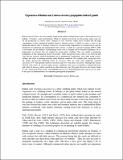Experiences of Rattan cane (Calamus deeratus) propagation trials in Uganda
Author
Date
2004Type
Articleviews
downloads
Metadata
Show full item recordxmlui.dri2xhtml.METS-1.0.item-citation
Experiences of Rattan cane (Calamus deeratus) propagation trials in Uganda Kalungi Evans, Kiwazi F., Busulwa H. and P. Mafabi Wetlands Inspection Division, Ministry of Water, Lands and Environment. P. O. Box 9629 Kampala Uganda; wetprog@imul.com
Abstract/
Rattan cane (Calamus deeratus) mainly found in the natural wetland forests and is harvested for use in making of baskets, cords and furniture. While its natural stock levels are decreasing, rattan cane use for the production of various items continues to rise. Previous studies have revealed that the high consumption of this commercial product from its natural reserves is likely to cause a crisis to the handicraft industry due to shortage created by over-harvesting, degradation of wetland forests and the breakdown of traditional and management trade systems. A study was carried out during 1998 to 2001 to investigate the possibilities of propagating rattan cane in Uganda and to formulate guidelines for its propagation in nurseries that are engaged in raising plant seedlings. This was aimed at promoting propagation of this endangered species on peoples’ farms and private forests after it was observed that some private nurseries needed information on its propagation. Experiments were done using suckers, cuttings and seeds as planting materials under different conditions. Five months after sowing the seeds, the results showed the following levels of successes: 80% for seeds with completely removed sarcotesta, 67% with partially removed sarcotesta and 43% with intact sarcotesta. Although the suckers showed some levels of survival under nursery conditions, they were susceptible to fungal infections and collar rot disease, which caused losses after about one year. The paper discusses the various media of soils, which give better results, and highlights the success of propagating rattan cane by use of seeds. It also gives recommendations on community propagation programmes

